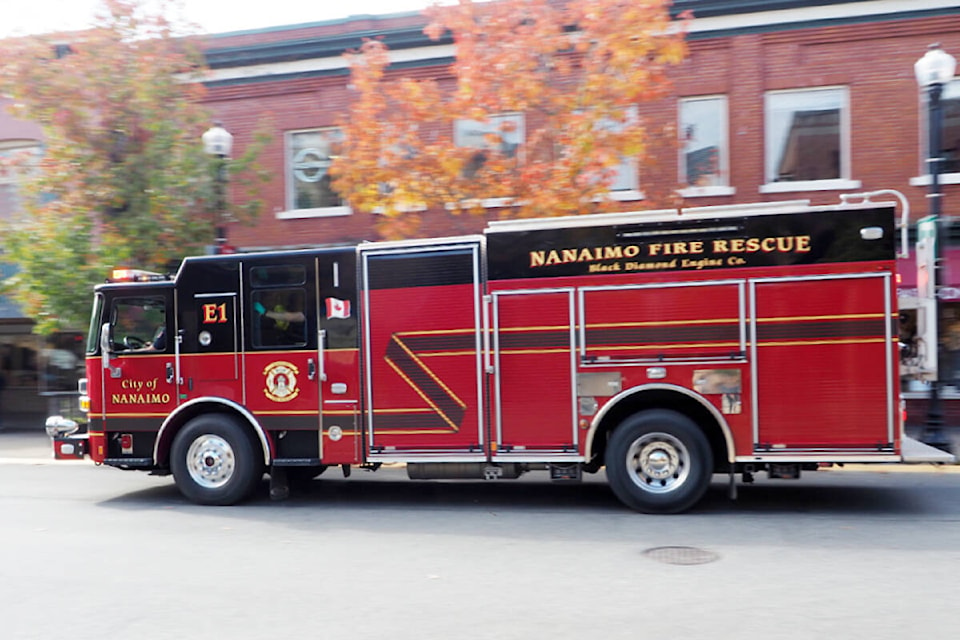Medical aid calls answered by Nanaimo Fire Rescue are climbing fast and so are the costs of responding to them.
At a Nanaimo city council meeting Monday, Nov. 6, Nanaimo fire chief Tim Doyle presented a report, requested this past spring, that contained information council described as discouraging but valuable.
The report’s purpose was to give a tally of the financial costs of attending medical calls and possibly point to ways the city could recover those costs from the province.
Nanaimo Fire Rescue has responded to both life-threatening and non life-threatening “low-acuity” medical aids for several decades. Under the emergency health care act, pre-hospital care is a provincial responsibility, but in practice, municipalities fund and provide the service with firefighters providing first response until B.C. Ambulance Service paramedics arrive to take over patient care and provide transport to hospital.
Medical aid call numbers have spiked in recent years for various reasons that include Nanaimo’s population growth, but illicit drug overdoses have become a major driver behind steeply rising numbers of life-threatening medical emergencies.
“In 2021, emerging from COVID – and there’s obviously other factors than this – but we responded to 507 overdoses,” Doyle said. “In 2022, that increased to 672 and, just this year … we were up to 1,500 overdoses … a large chunk of our medical calls is due to the illicit drug crisis.”
Nanaimo’s firefighters responded to nearly 9,900 calls of all types in 2022, with 57 per cent for medical aids of all types and 43 per cent non-medical. Estimates for 2023 put Nanaimo firefighters on track to respond to more than 12,000 by year’s end. Doyle said from Jan. 1 to Aug. 31, his department responded to 8,060 incidents, including 5,888 medical calls and 2,672 non-medical calls, which works out to about 68 per cent and 32 per cent respectively.
“There has been a jump … that can pretty squarely be attributed to the toxic drug crisis,” Doyle said. “We’re seeing a huge increase in illicit drug use calls [for] overdoses.”
To meet the growing demand for response to life-threatening and time-critical medical aid calls and provide higher level of care until B.C. Ambulance crews can get on scene, Nanaimo Fire Rescue started boosting firefighter training to emergency medical responder level in 2020, a five-year program that will be complete in 2025. The department is also in the process of adding 40 more firefighters.
In 2022, the fire department’s costs to respond to more than 5,700 medical incidents totalled approximately $154,000, which includes fleet expenses such as insurance, repairs, fuel and maintenance; and first responder supplies such as gloves, masks, naloxone and other consumables. But when staff wages and benefits are factored in the total cost jumps more than $438,000 for a total of $592,000 or nearly 2.8 per cent of the fire department’s $21.3-million total operating budget.
Medical aid calls are also time consuming, but it could be comparatively worse, because Nanaimo isn’t seeing the long delay times for ambulances to medical aid scenes being experienced in other parts of B.C., Doyle said.
“Why that’s important is because the fire department doesn’t transport patients to the hospital and once we make patient contact we can’t leave the patient,” he said. “So, if there’s not enough B.C. Ambulance resources in the community when we go to a call, if they can’t respond in a timely manner, it means we’re tied up tending [to] the patient.”
Doyle said he knows of some fire departments that no longer respond to low-acuity incidents so as to not be tied up with those calls in the event they are needed at a high-priority incident, but this was not a strategy he was suggesting.
Coun. Ian Thorpe asked about the possibility of the department being overwhelmed by multiple simultaneous calls, and Doyle said Nanaimo Fire Rescue experiences concurrent calls about 20 per cent of the time. That is mitigated by the recent addition of a fifth fire engine and staff, and a sixth engine and staff is set to be added in 2025, but there is concern about the continual rise in calls.
“It’s definitely a concern when we can see this trend growing with illicit drug overdoses … If we grow by 2,000 calls and over 1,000 of them are going to be in overdoses alone, it’s definitely a concern,” he said.
READ ALSO: 21 recruits start training all at once with Nanaimo Fire Rescue
